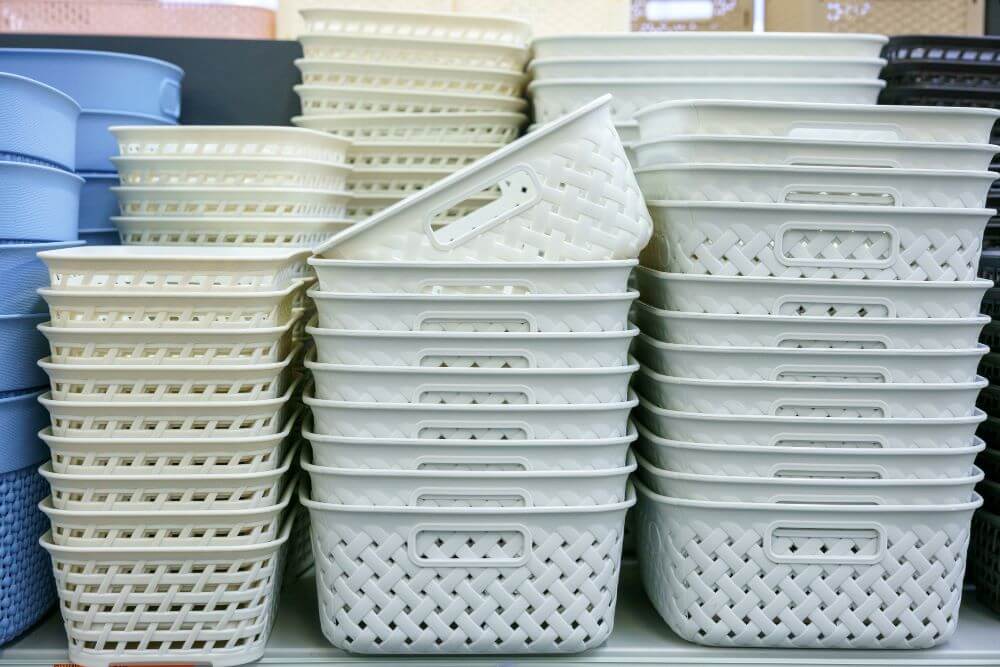Space saving is often a key focus for many businesses. However, it’s still overlooked or people just don’t know how to do it in a workspace. Though keeping everything in place is the option, the way you’re placing them matters. Stackable totes are something that sort this mess up. It helps you well-organize your goods, categorize them, and stack them vertically to save space while making them easier to find. Let’s take a deep dive into it and see what benefits they pack.
Design Features That Make a Difference
A good tote does more than hold items. It has to work well with others in the stack. Many models include interlocking bases and lids, which keep them steady even when stacked high. This simple feature lowers the risk of tipping and helps protect whatever is inside.
Label areas or cardholders are another small but useful detail. A quick glance tells you what’s inside, which keeps things moving in busy environments. Some totes add ergonomic hand grips so they are easier to lift and carry, even when they are full.
Versatility Across Industries
Stackable storage totes aren’t a one-sector wonder. The best part about them is their versatility and quick accessibility. In retail, you can use them to ease up your stock management by keeping seasonal goods stacked well to retrieve them easily. Warehouses can also take advantage with space optimization and clean organization.
Then there’s the healthcare sector that uses these storage bins to keep their stuff like gloves, syringe, or small equipment organized. The transparency and labeling option makes things more convenient as you can locate items in no time.
Food, another major industry, relies on them to shift ingredients safely while keeping perishable and dry goods separate.
To give you a quick rundown, here’s how stackable totes work in different sectors:
| Industry | Use Cases |
| Retail | Seasonal stock storage and retrieval |
| Healthcare | Supply organization for quick access |
| Food service | Ingredient segregation and transport |
| Manufacturing | Parts storage on assembly lines |
This versatility makes stackable totes more than storage containers. They act as silent partners in smooth operations across industries.
How Stacking Improves Workflow and Reduces Clutter
Productivity dips in a cluttered workspace. And stackable totes are made to banish this mess. While being simple, they offer an effective solution by keeping tools, products, and supplies sorted and organized vertically rather than scattered across valuable floor space.
A right-structured stacking system keeps things in front of your employees’ eyes, reducing that hectic time they spend searching for something restlessly.
Imagine if you’re working on your desktop that’s randomly organized, you’d waste plenty of time searching for the right information. In fact, there’s a McKinsey report showing that employees waste 1.8 hours/day just looking for information.
You don’t want this to happen at your physical office. If yes, stackable totes can act as a time saver here. With stackable totes, wasted time can shrink dramatically since everything’s correctly labeled and easily accessible.
Digging more into the benefits will reveal that you get:
- Faster access: Well-labeled totes eliminate guesswork.
- Space optimization: Vertical storage frees up walking space.
- Cleaner workstations: Clutter is reduced, leading to safer operations.
Let’s say there’s a busy warehouse that’s already cramped and filled with random boxes spread here and there. It clogs the aisles, eats up the floor space, and you’ll end up watching your employees navigate their way like they’re stuck in a life-sized puzzle. That’s a recipe for wasted time searching for important stuff.
On the contrary, in a warehouse where stackable totes are used, the floor stays clear, stuff stays organized, and workers move freely. In the end, you’ll see more work getting done, a more productive team, and minimal downtime.
Which side are you on? Do you prefer a messy space where your basic job becomes a challenge due to tricky navigation and floor space? Or you like a place that’s neat, well-organized, and spacious? If you prefer the latter, stackable storage totes are your thing.
Material Considerations for Longevity
The material used determines the life of your stackable storage tote. The most common material here is plastic for obvious reasons. It’s lightweight, durable, and moisture-resistant. For heavy-duty environments, high-density polyethylene (HDPE) or polypropylene (PP) work wonders, since they don’t crack easily.
If the need is to handle sensitive materials, FDA-approved plastics are necessary to adhere to safety and compliance norms.
Key material comparisons:
| Material | Strength | Best Use Case |
| Standard plastic | Moderate | Light retail or office storage |
| HDPE/Polypropylene | High | Warehousing, manufacturing |
| Recycled plastic | Varies | Eco-conscious operations |
While investing in stackable totes, you don’t want something that’s temporary and needs to be replaced soon. So, investing in the right material becomes paramount to ensure they remain in top shape literally. Choosing the right material keeps you from replacing them frequently, eventually saving you money in the long run.
Safety and Stability Tips When Stacking
While stackable storage totes are filled with benefits, mis-stacking them can lead to hazards. To keep your staff and goods safe, you can follow a few simple and practical tips:
- Even weight distribution: Heavier totes should always be at the bottom, while the lighter ones are on top.
- Avoid overfilling: Do not overfill them. The lids should always seal the bins well so that nothing falls off during retrieval.
- Check stacking capacity: Every tote has a maximum load rating.
- Use locking lids or interlocking designs: This prevents slipping or sliding.
Imagine a healthcare space where medicines are stored in totes. If heavy medicines like syrups within glass bottles, etc., are placed on top of lighter medicine boxes, they can topple, leading to damaged medicines and injuries. Organizing them well can lead to safer goods and employees.
If you have to deal with multiple types (or categories) of goods, you can try color-coded totes to quickly identify what you want, reducing the search time.
Cost Savings Over Time
Don’t let that bigger upfront investment intimidate you in the beginning. That’s because in the case of stackable totes, the finance works out in your favor in the long run. A durable tote, made with long-lasting materials like polypropylene (PP) or high-density polyethylene (HDPE), can last longer than you think. They don’t break down easily, unlike those flimsy cardboard boxes or containers.
Stackable totes bring you benefits like:
- Lower replacement costs: You don’t need to buy new packaging every now and then since the same totes can work for multiple trips.
- Reduced product damage: Stable stacks protect goods, which saves money otherwise lost to damaged inventory.
- Labor efficiency: Damaged inventory inflates your operational costs. With stackable totes, your workers can search for things in a jiffy and move clutter with ease.
When you add these up, stackable totes can quickly pay for themselves.
Customization Options for Different Workflows
Not all storage needs are the same. The best part about stackable totes is how easy they are to customize.
If there are some seasonal stock retailers that don’t want to mix with daily inventory, they use color-coded totes. In manufacturing, dividers can be easily inserted to segregate small parts so the workers don’t waste their time searching through mixed bins.
Want your totes to reflect your branding? There is something available for that need. There are suppliers who let businesses print logos or labels directly on the totes. While it looks a trivial step, it reinforces the branding for a professional presentation. Eventually, the right customization in those totes will turn these stock holders into a workflow booster.
Environmental Benefits of Reusable Totes
What’s reusable is always eco-friendly, even if it is made with plastic. They might not look or sound like an environmentally good solution (since they’re made of plastic), but stackable totes can actually contribute to sustainability goals without any major changes in your daily operations. Instead of dozens of single-use boxes or bags, stackable totes would do. The result is fewer materials that end up in landfills.
As shown by a study, reusable plastic containers, compared to single-use display-ready corrugated cardboard trays, require 39% less energy, generate 95% less solid waste, and emit 29% less greenhouse gas.
And the benefits don’t end here. PP and HDPE, the material stackable totes are made of are recyclable. So, even if a tote reaches its end of life, it can be recycled to continue this eco-friendly loop.
Where Stackable Totes Make the Biggest Impact
While stackable totes are versatile, certain industries see the most dramatic benefits. Warehousing and logistics top the list. With storage often running into thousands of items, vertical organization is crucial for smooth order fulfillment.
In retail, totes help in backroom organization where seasonal or promotional items rotate frequently. Quick stacking and unstacking save employees time during busy sales periods. Healthcare also experiences major improvements as medical staff access labeled supplies in seconds during emergencies.
High-impact sectors at a glance:
| Industry | Impact of Stackable Totes |
| Logistics | Faster picking and shipping processes |
| Retail | Streamlined seasonal stock management |
| Healthcare | Rapid supply access in critical moments |
| Food service | Safe, organized transport of perishables |
These totes don’t just optimize storage; they reshape how industries operate. The biggest impact lies in turning chaotic spaces into efficient, accessible, and safe environments.
Practical Uses in Everyday Operations
Stackable totes shine in day-to-day workflows. Be it warehouses, offices, classrooms, and even homes, they work wonders in different spots and scenarios. Let’s have a look at their application in different spots:
- Offices: Documents, stationary, electronics, etc., can be stored to keep the place clutter-free, making it easy to find things when you need them.
- Schools: From books and sports gear to art supplies, stackable storage totes can make things organized and accessible.
- Workshops: Tools and parts stay sorted, reducing downtime during repairs.
- Homes: From closets to garages, stackable totes simplify organization for families.
The practicality of stackable storage totes lies in their adaptability. Be it space-saving, speeding up retrieval, or creating portable storage, these storage bins come out as a reliable solution for day-to-day operations.
Smarter Storage With Minimal Effort
There’s a popular trend going on among people who love gardening. It’s called vertical gardening. It’s for those who don’t have enough space and still want to grow plants, especially indoors. The reason behind the vertical garden’s popularity is its space-saving ability. Since you place the plants vertically here, it takes a lot less space compared to those pots placed on the floor. The same concept applies to stackable totes.
Since they’re aligned vertically, they save the floor space that’s often required for the smooth and free movement of your workers. Plus, these bins keep your stuff sorted, saving you time you could’ve wasted on searching for something.
Another positive about them is that they’re long-lasting and recyclable. So, there’s no need to replace them frequently and even when their life’s about to end, you can recycle them for reuse. In short, stackable storage totes are the smarter storage solution that is beneficial for both you and the planet.






